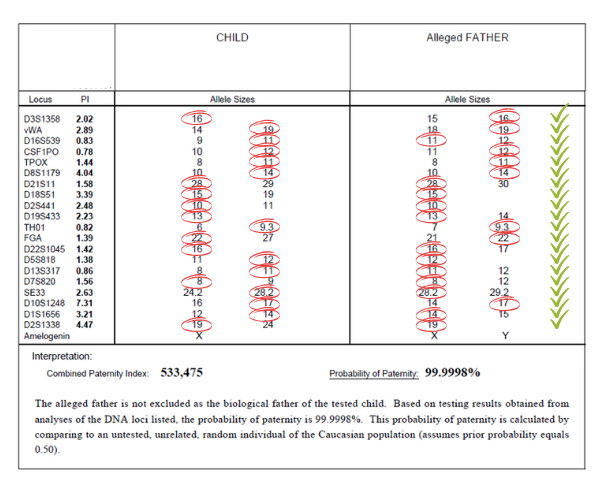How To Get A Copy Of Paternity Test Results

How to Read Your Paternity Test Results
DNA Diagnostics Center (DDC) is the world leader in DNA Paternity Testing, performing over one million paternity tests each year. Each test is processed at our state-of-the art facility outside Cincinnati, providing online results as soon as 24 to 48 hours after the samples arrive at our lab and go into testing. This detailed paternity test report contains scientific as well as legal terms to describe our highly precise process and your results. Here's a breakdown of the different sections in the report, and what they mean for you and your family.
WATCH VIDEO >
DDC Paternity Test Results Report Overview
Your DDC paternity test results report contains the following main sections, with each displaying important information.
- Genetic System Table (Locus/Allele Sizes chart)
- Combined Paternity Index
- Probability of Paternity
- Test Conclusions
Call us for a FREE confidential consultation at 800.929.0847. We're here to help.
Paternity Test Results: Genetic System Table
DDC's laboratory tests at least 20 different locations on your DNA, as listed in the "locus" column, and compares them with the same locations on the other tested parties. Each child inherits one copy of this DNA segment from the mother, and one copy from the father. These DNA segments are called "alleles". Our proprietary technology determines the length of each participant's alleles and compares them with the lengths of the alleged father's alleles to determine the number of matches. If the mother participates, the mother's alleles will also be compared. In the example below, the child shown has two sets of alleles at each location tested, and you can see that at least one of these matches with the alleged father's alleles.

Note: Colored markings are for illustrative purposes only and are not included on actual reports.
Using statistics, the Paternity Index (listed as PI in the table in the upper left) indicates the strength of the match at each Locus (DNA location). In most cases, at least one of the child's alleles at each location must match one of the father's at that location. In addition, the DNA location that shows a participant's sex (male or female), called the Amelogenin locus, is also tested. This is listed at the bottom of the table. One X means female, while one X and one Y means male. Sometimes additional locations on your DNA must be tested to strengthen the results – for example, when two possible fathers are relatives. In this case, those are also listed. When a child has two alleles that are the same size, it will show as just one number on the table. For example, in the first locus in this example, the child received a "16" from both parents.
Call us for a FREE confidential consultation at 800.929.0847. We're here to help.
Paternity Test Results: Combined Paternity Index
The Combined Paternity Index is the number on the lower left side of the report (in the Interpretation section), directly under the Genetic System Table. If you are considered the biological father, there is a number listed for the Combined Paternity Index. If you are not considered the biological father, the report shows "0." The Combined Paternity Index is an odds ratio indicating how many times more likely it is that the possible father is the biological father than a randomly-selected unrelated man with a similar racial background. In the example shown above, this man is 533,475 times more likely to be the biological father. This number varies on a case by case basis. The higher this number, the stronger the results.
Paternity Test Results: Test Conclusions
The report also shows one of two conclusions: "is not excluded as the biological father" or "is excluded as the biological father."
- If the conclusion states, " is not excluded as the biological father," this means the possible father most likely IS the biological father of the child, since all data gathered from the test supports a relationship of paternity.
- If the conclusion states, " is excluded as the biological father," this means the possible father IS NOT the biological father of the child, since all data gathered from the test do not support a relationship of paternity.
Call us for a FREE confidential consultation at 800.929.0847. We're here to help.
Frequently Asked Questions
Q: My test shows a mismatch in one location between the possible father and the child, yet the probability of paternity is over 99%. How can this happen?
A: Chances are good that there was a mutation in either the child's or the possible father's genetic code at that location. Analysts take mutations into account when doing their calculations and reaching conclusions. So even if there is a mismatch, the man might still be considered the biological father of the child tested.
Q: Can your paternity test results be wrong?
A: DDC processes every sample twice, by a separate team of technicians, to eliminate the possibility of human error for extremely accurate results. If your results say that the alleged father is "excluded", this means there is zero probability that the person is the biological father, based on the DNA analysis. If your results say that the father is "not excluded", this means that there is almost 100% probability that the person is the biological father – in the example above, a 99.9998% probability. However, if two possible fathers are close relatives, such as brothers, they share much of the same DNA. It is important to let us know if two possible fathers are relatives. We can do additional testing to increase accuracy in this situation.
Q: Why aren't there names on my paternity test report?
A: When doing an at-home test, there are no names on the report, only an identifying number for each set of samples and their role in the test (alleged father, child, or mother). We do this because we cannot verify whether a sample submitted to us belongs to the person indicated by the customer. However, if you choose to do a legal, witnessed, chain-of-custody paternity test with court-admissible results, then the report includes both names and our company branding. For both at-home and legal testing, the testing process itself is exactly the same, and you can be sure results are guaranteed accurate for the samples provided to us.
Q: Can the Probability of Paternity ever be 100%?
A: No. DNA test results are calculated based on statistics. Quite simply, in order to get a 100% probability, we'd have to test every man in the world with a similar ethnic background to the alleged father being tested. And for obvious reasons, that's not possible!
About DNA Diagnostics Center (DDC)
DNA Diagnostic Center is the world leader in paternity and relationship testing. We serve healthcare professionals, government agencies, and individuals around the world to determine family relationships with trusted accuracy.
More Questions? Don't hesitate to call us at 800-929-0847. We're here to help. Note: If you have performed a Non-Invasive Prenatal Paternity Test, a paternity test conducted during pregnancy, your results will contain different information. For help understanding a prenatal report, or to order a Prenatal Paternity Test, please contact our prenatal testing specialists at 1-800-929-0847 (M-F, 8 am to 5 pm Eastern).
If you have a general question about the info above, leave a comment and we'll answer.
How To Get A Copy Of Paternity Test Results
Source: https://dnacenter.com/blog/understanding-paternity-test-results/
Posted by: rawlsparunt.blogspot.com

0 Response to "How To Get A Copy Of Paternity Test Results"
Post a Comment